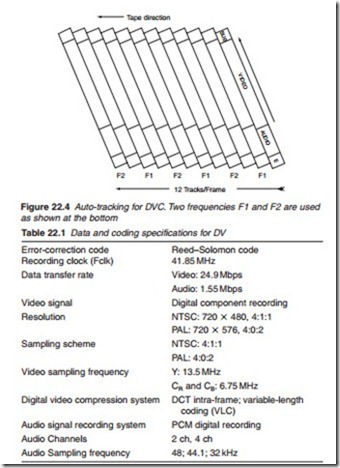DV track configuration
DV head drums have a diameter of 21.7 mm, and rotate at 9000 rpm to give a writing speed of about 10 m/s. Two video heads are fitted, with azimuth angles of ±20º: this amounts to a 40º offset between them, with a corre- spondingly low level of cross talk pick-up from adjacent tracks. The heads are very narrow to give a track pitch of just 10 1m in SP, 6.67 1m in LP mode, corresponding to tape speeds of 18.8 and 12.6 mm/s respectively. The tape’s helical wrap embraces 186º of the drum’s periphery; the signal envelope is clipped at the 180º point by the head switch.
A complete picture frame (with corresponding sound signals) takes 12 tracks for PAL and 10 tracks for NTSC. Figure 22.3 shows the track arrange- ment for NTSC. Each 32.89-mm-long track consists of four segments, written sequentially by one head as it scans across the tape at an angle of 9.167º. First comes the insert and tracking information (ITI) segment, containing refer- ence data for track height/positioning and to provide a tracking signal for audio and video dubbing and inserts. The ITI data is used purely for ‘house- keeping’ purposes by the VCR itself during playback. The next two segments are the audio and video data we have already met; in the video sector are recorded additional data such as date and time of recording, camera settings,
widescreen mode flag, etc. These can be displayed during replay if required. The final sector in the tape track shown in Figure 22.3 contains sub-code data, primarily a time code which can be used to identify every frame, useful for editing. Also in the sub-code are cue flags for location of each new shot, and for marking still-frame/photo shots when the camera is set to that mode.
DV tracking system
As with the Video-8 format described in the previous chapter, automatic head-tracking during replay is carried out using ‘tones’ recorded along the tracks. In DV the system is simpler than for Video-8, as Figure 22.4 shows. Here two tone frequencies are used, 465 and 697 KHz, alternating with no recorded tone in a four-track sequence. When scanning a track with no pilot tone the off-tape F1 and F2 cross talk signals are made equal by the tracking-servo system, signifying a track-centre trajectory of the head; this condition corresponds to maximum pilot-tone amplitude during replay of an F1 or F2 track.
